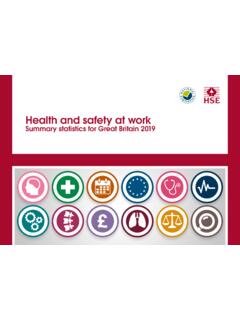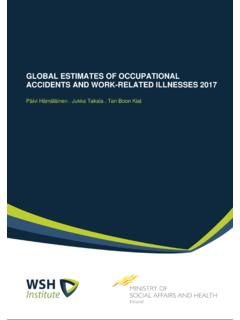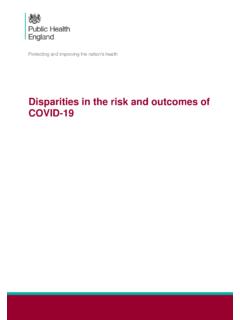Transcription of 2019 - WHO
1 201920192019 World health statistics 2019: monitoring health for the SDGs, sustainable development goalsISBN 978-92-4-156570-7 World Health Organization 2019 Some rights reserved. This work is available under the Creative Commons Attribution-NonCommercial-ShareAlike IGO licence (CC BY-NC-SA IGO; ). Under the terms of this licence, you may copy, redistribute and adapt the work for non-commercial purposes, provided the work is appropriately cited, as indicated below. In any use of this work, there should be no suggestion that WHO endorses any specific organization, products or services. The use of the WHO logo is not permitted. If you adapt the work, then you must license your work under the same or equivalent Creative Commons licence. If you create a translation of this work, you should add the following disclaimer along with the suggested citation: This translation was not created by the World Health Organization (WHO).
2 WHO is not responsible for the content or accuracy of this translation. The original English edition shall be the binding and authentic edition .Any mediation relating to disputes arising under the licence shall be conducted in accordance with the mediation rules of the World Intellectual Property citation. World health statistics 2019: monitoring health for the SDGs, sustainable development goals. Geneva: World Health Organization; 2019. Licence: CC BY-NC-SA (CIP) data. CIP data are available at , rights and licensing. To purchase WHO publications, see To submit requests for commercial use and queries on rights and licensing, see materials. If you wish to reuse material from this work that is attributed to a third party, such as tables, figures or images, it is your responsibility to determine whether permission is needed for that reuse and to obtain permission from the copyright holder.
3 The risk of claims resulting from infringement of any third-party-owned component in the work rests solely with the disclaimers. The designations employed and the presentation of the material in this publication do not imply the expression of any opinion whatsoever on the part of WHO concerning the legal status of any country, territory, city or area or of its authorities, or concerning the delimitation of its frontiers or boundaries. Dotted and dashed lines on maps represent approximate border lines for which there may not yet be full agreement. The mention of specific companies or of certain manufacturers products does not imply that they are endorsed or recommended by WHO in preference to others of a similar nature that are not mentioned. Errors and omissions excepted, the names of proprietary products are distinguished by initial capital reasonable precautions have been taken by WHO to verify the information contained in this publication.
4 However, the published material is being distributed without warranty of any kind, either expressed or implied. The responsibility for the interpretation and use of the material lies with the reader. In no event shall WHO be liable for damages arising from its use. Photo credits: WHOD esign and layout by L IV Com S rl, SwitzerlandPrinted in SwitzerlandiiiMONITORING HEALTH FOR THE SDGsCONTENTSF oreword ..vAbbreviations ..viIntroduction ..11. Life expectancy and causes of death ..32. Reproductive and maternal health ..103. Newborn and child health ..164. Infectious diseases ..235. Noncommunicable diseases ..316. Injuries and violence ..367. Environmental risks ..408. Universal health coverage and health systems ..469. Summary of findings ..5310.
5 Highlights and ways forward ..61 References ..63 Annex 1. Regional highlights of health-related SDG indicators ..67 Annex 2. Tables of health statistics by country, WHO region and globally ..81 Annex 3. WHO regional groupings ..120vMONITORING HEALTH FOR THE SDGsDr Tedros Adhanom Ghebreyesus Director-GeneralWorld Health OrganizationFOREWORDFor 71 years, the World Health Organization (WHO) has had one vision: the highest attainable standard of health for all people in all countries. Reliable data are vital for assessing whether we are making progress towards that vision, for highlighting areas of progress and for exposing where we need to change trends are constantly evolving, and so are health systems. No health system is perfect, and all countries have people who are left behind.
6 It is therefore important to accurately document the state of global health and how it is changing. The World health statistics, published annually since 2005, is WHO s annual snapshot of the state of the world s health. Since 2016, the World Health Statistics series has focused on monitoring progress toward the Sustainable Development Goals (SDGs), and the 2019 edition contains the latest available data for the health-related SDG SDGs address inequality wherever it exists. The 2019 edition reports on trends over time and disaggregates data by WHO region, World Bank income group, and sex to identify key inequalities. The report reveals that in low-income countries, health is frequently compromised by diseases and conditions that are preventable or treatable. Many premature deaths are associated with environmental factors or the leading underlying causes of death, such as tobacco use, unhealthy diet, physical inactivity and unhealthy consumption of alcohol.
7 Although the World health statistics 2019 tells its story with numbers, the consequences are human. In low-income countries, one woman in 41 dies from maternal causes, and each maternal death greatly affects the health of surviving family members and the resilience of the community. Not only are the risks of maternal deaths elevated by poverty, but their occurrence perpetuates the cycle of poverty in poor communities from one generation to the must be relentless in our pursuit of solutions to such human tragedies, and our responses must be informed by robust, reliable data on health risks, access to services and health outcomes. At present, many countries lack the health information systems they need to accurately monitor health trends and inform decision-making.
8 That is why WHO is creating an entirely new process for strategic policy dialogue with countries, using evidence and information strategically to drive will continue to work with countries to strengthen their information systems for health and generate better data. We will also build a modern data backbone that allows sharing and analysis of data among the three levels of WHO and countries. And we will make investments to strengthen analytical capacity at all levels, to identify trends, make projections and support acceleration of progress toward achieving health every number in these pages is a person, a family, a community and a nation. My hope is that governments, health providers, academics, civil society organizations, the media and others use these numbers to promote health.
9 Keep the world safe and serve the HEALTH STATISTICS 2019 AFRWHO African Region AIDS acquired immunodeficiency syndrome AMRWHO Region of the Americas COPD chronic obstructive pulmonary disease COSIC hildhood Obesity Surveillance InitiativeCRDchronic respiratory disease CRVS civil registration and vital statisticsCVDcardiovascular disease DHSdemographic and health surveysDTP3diphtheria-tetanus-pertussis third dose EMRWHO Eastern Mediterranean Region EURWHO European Region FGMfemale genital mutilationGGEgeneral government expenditure GHOG lobal Health ObservatoryHALE healthy life expectancy HBVhepatitis B virusHEShealth examination surveyHIhigh income HIVhuman immunodeficiency virus IHRI nternational Health Regulations ITNinsecticide-treated mosquito netLACL atin America and the CaribbeanLIlow income LMIlower-middle income LMIClow- and middle-income countriesM/Fmale to female (ratio)
10 MCV2measles-containing vaccine second dose MISmalaria indicator surveysMMRmaternal mortality ratiosNCDnoncommunicable disease NTDneglected tropical disease ODAofficial development assistance PAHOPan American Health Organization PCV3pneumococcal conjugate vaccine third dose PPPpurchasing power parityPrEPpre-exposure prophylaxisSCIservice coverage indexSDGS ustainable Development GoalSEARWHO South-East Asia Region TBtuberculosis UHCuniversal health coverage UMIupper-middle income UNUnited NationsUNICEFU nited Nations Children s FundWASH water, sanitation and hygiene for all WBWorld Bank WHOW orld Health Organization WPRWHO Western Pacific RegionABBREVIATIONS1 MONITORING HEALTH FOR THE SDGsINTRODUCTIONThe World Health Statistics series is the World Health Organization s (WHO s) annual compilation of health statistics for its 194 Member States.















